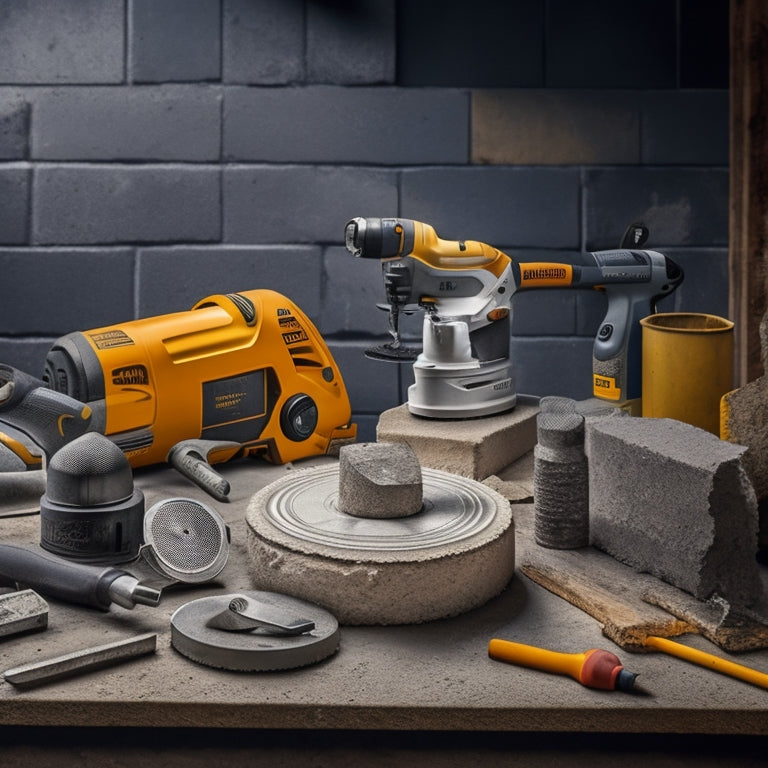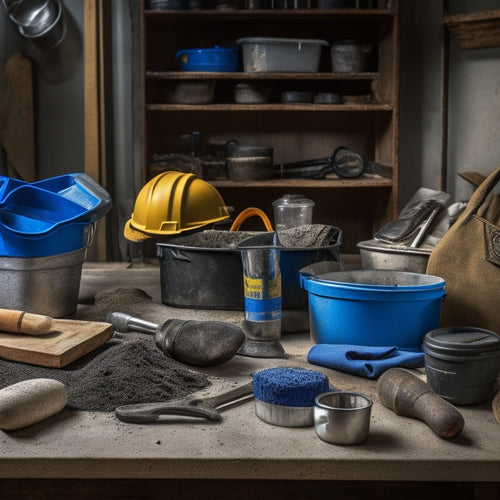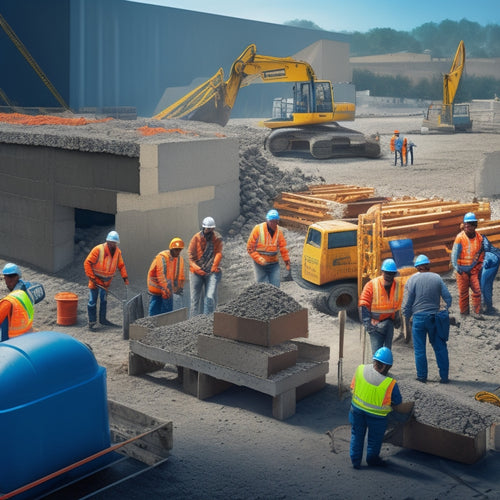
What Tools Cut Concrete Blocks Efficiently
Share
You'll need a combination of specialized power saws, block splitting machines, and hand tools to efficiently cut concrete blocks, with the right choice depending on the specific task, block type, and desired level of precision. Diamond-coated blades and handheld saws are essential for dense concrete, while concrete cutting circular saws make clean, straight cuts. Block splitting machines provide unmatched power, and wet tile saws offer precision cuts. Masonry saws and diamond blade cutting equipment are ideal for heavy-duty applications, while electric concrete block saws and block chiseling hammer tools offer versatility. Now, let's explore the finer details of each tool to achieve excellent results.
Key Takeaways
• Diamond-coated blades and handheld saws are essential for efficient cutting through dense concrete with minimal kickback.
• Block splitting machines, such as hydraulic block splitters, provide unmatched power and control for quick, clean splits.
• Wet tile saws with high-quality blades and water cooling systems maintain peak performance and prevent overheating during cutting.
• Masonry saws with the right blade selection, such as diamond or abrasive blades, are crucial for precision and efficiency in concrete cutting.
• Electric concrete block saws with high-torque motors and water cooling systems reduce dust and debris, enhancing safety and efficiency.
Power Saws for Cutting Blocks
When cutting concrete blocks, you'll typically reach for a power saw equipped with a diamond-coated blade, as it can efficiently slice through the dense material with minimal kickback and vibration. This setup allows you to make precise cuts with reduced fatigue.
Handheld saws, in particular, offer excellent maneuverability, making them ideal for curved cuts or working in tight spaces. To optimize your cutting technique, maintain a steady pace, applying consistent pressure while keeping the saw blade straight. This will help prevent wobbling and guarantee a clean cut.
Additionally, it's crucial to keep the saw blade clean and well-lubricated to prevent overheating and extend its lifespan. By mastering these cutting techniques, you'll be able to tackle even the most demanding concrete block cutting tasks with ease.
Remember to always follow safety guidelines and wear protective gear when operating power saws to minimize the risk of injury. With the right tools and techniques, you'll be able to cut concrete blocks like a pro.
Block Splitting Machines
You'll turn to block splitting machines for tasks that require breaking down concrete blocks into smaller, more manageable pieces, as these machines can apply precise amounts of pressure to achieve clean, controlled splits.
These machines are ideal for block splitting techniques that demand accuracy and precision. Hydraulic block splitters, in particular, offer unparalleled power and control. By generating massive force, they can split concrete blocks quickly and efficiently, without causing damage or fragmentation.
When choosing a block splitting machine, consider the force required for your specific task. Look for machines with adjustable pressure settings to guarantee you can tailor the force to your needs.
Additionally, consider the machine's capacity, as well as its durability and maintenance requirements. A high-quality block splitting machine will save you time and effort, while also guaranteeing a high-quality finish.
Concrete Cutting Circular Saws
For tasks that require making precise cuts in concrete blocks, rather than breaking them down into smaller pieces, you'll reach for concrete cutting circular saws, which offer a high degree of accuracy and control.
These saws are designed to make clean, straight cuts in concrete and are ideal for applications where precision is paramount.
When using concrete cutting circular saws, it's crucial to employ proper cutting techniques and safety precautions to get the best results.
Here are some key considerations to keep in mind:
-
Always wear protective gear, including gloves, safety glasses, and a dust mask.
-
Use a saw with a diamond-coated blade, which is specifically designed for cutting concrete.
-
Make slow, steady passes through the concrete, applying gentle to moderate pressure.
-
Keep the saw blade cool by spraying it with water periodically.
-
Make sure the saw is properly maintained and serviced to prevent kickback and other hazards.
Wet Tile Saws for Blocks
When you're working with wet tile saws for blocks, you'll quickly realize that the quality of the blade is essential.
You'll also appreciate the importance of a reliable water cooling system, which helps to prevent overheating and extend the blade's lifespan.
As you put these saws to the test, you'll notice the precise cutting action they provide, making them an excellent choice for cutting concrete blocks.
Blade Quality Matters
Cutting through concrete blocks efficiently requires selecting a high-quality blade specifically designed for wet tile saws, as it directly impacts the performance and longevity of your tool. A high-performance blade is essential for achieving precise cuts and minimizing wear and tear on your saw.
When choosing a blade, consider the following key factors that affect blade performance:
-
Material composition: Look for blades made from high-carbon steel or diamond-coated edges for maximum durability and cutting efficiency.
-
Teeth configuration: Blades with a specific tooth pattern and spacing are designed to tackle concrete blocks, guaranteeing clean cuts and reduced vibrations.
-
Blade width and thickness: A wider, thicker blade provides more stability and helps prevent binding or kickback.
-
Blade maintenance tips: Regularly clean and inspect your blade to prevent rust and corrosion, and store it properly to maintain its edge.
-
Blade performance factors: Consider the blade's RPM and horsepower ratings to confirm they match your saw's capabilities, guaranteeing peak performance and blade longevity.
Water Cooling System
You'll need a reliable water cooling system to effectively operate your wet tile saw for cutting concrete blocks, as it plays a critical role in maintaining peak blade performance and preventing overheating.
A well-designed cooling system guarantees the water temperature remains stable, typically between 50°F to 70°F, to enhance blade performance. This temperature range allows for efficient heat dissipation, reducing the risk of blade damage and prolonging its lifespan.
To achieve maximum cooling efficiency, look for a system with a high flow rate, typically above 1 gallon per minute. This guarantees a consistent supply of cool water to the blade, preventing overheating and reducing wear.
Additionally, consider a system with a built-in water filtration mechanism to remove debris and contaminants, which can impede cooling efficiency. A reliable water cooling system is essential for maximizing your wet tile saw's cutting performance and extending its lifespan.
Precise Cutting Action
By utilizing a wet tile saw specifically designed for cutting concrete blocks, you can achieve precise cutting action with minimal vibration and maximum control. This is essential when working with concrete blocks, as accuracy is key to guaranteeing a professional finish.
With a wet tile saw, you can execute cutting techniques with precision measurements, guaranteeing clean, straight cuts every time.
Here are some benefits of using a wet tile saw for cutting concrete blocks:
-
Consistent Cutting: The saw's fixed blade and precise guide system guarantee consistent cutting results, even for complex cuts.
-
Reduced Vibration: The wet tile saw's design minimizes vibration, allowing you to maintain control and accuracy throughout the cutting process.
-
Coolant System: The saw's built-in coolant system helps to reduce heat buildup, preventing damage to the blade and the concrete block.
-
Adjustable Cutting Depth: Easily adjust the cutting depth to accommodate blocks of varying thickness.
-
Ergonomic Design: The saw's ergonomic design reduces operator fatigue, allowing you to work efficiently for extended periods.
Masonry Saws for Precise Cuts
When you're working with masonry saws for precise cuts, you'll want to focus on two key aspects to guarantee ideal results.
First, you'll need to select the right blade for your specific concrete block cutting task, as the wrong one can lead to subpar cuts or even damage to the saw.
Additionally, don't forget to take into account the importance of dust control systems, which can help minimize mess and improve overall safety.
Blade Selection Matters
Selecting the right blade for your masonry saw is essential, as it directly impacts the precision and efficiency of your cuts in concrete blocks. You want to make sure you're getting the most out of your saw, and that means choosing a blade that's up to the task.
When it comes to blade materials, you've got options. Here are a few things to evaluate:
-
Diamond blades: These are your go-to for heavy-duty cutting. They're durable and can handle even the toughest concrete blocks.
-
Abrasive blades: A cost-effective option for smaller projects. They're not as durable as diamond blades, but still get the job done.
-
Segmented blades: These blades are designed for fast, aggressive cutting. They're perfect for larger projects where speed is key.
-
Continuous rim blades: These blades are designed for precision cutting. They're perfect for smaller, more intricate cuts.
-
Blade maintenance: Don't forget to clean and maintain your blade regularly. A dull blade is a slow blade, and that means wasted time and energy.
Dust Control Systems
You'll need a reliable dust control system to keep your workspace clean and your cuts precise, especially when working with masonry saws. Dust control is vital for efficient dust management, as it prevents airborne particles from interfering with your work and reduces the risk of respiratory issues.
A well-designed dust control system incorporates advanced dust extraction techniques to capture particles at the source, minimizing dust dispersion. This guarantees a cleaner workspace, reduced cleanup time, and improved operator safety.
When selecting a dust control system, look for features such as high CFM ratings, efficient filter systems, and adjustable suction control. These features enable you to tailor the system to your specific application, guaranteeing peak performance and dust management.
Additionally, consider a system with a built-in vacuum or dust collection unit, which can be easily emptied and maintained. By investing in a reliable dust control system, you'll be able to work more efficiently, make more precise cuts, and maintain a safe working environment.
This is especially important when working with masonry saws, as precise cuts require a clean and controlled workspace.
Block Chiseling Hammer Tools
Using a block chiseling hammer tool, you can efficiently split concrete blocks along their score lines, allowing for precise control over the breaking process. This method is ideal for making precise cuts and achieving clean breaks. With the right chisel techniques and hammer types, you can tackle even the toughest concrete blocks.
Here are some key considerations when using block chiseling hammer tools:
-
Choose the right hammer type: Select a hammer that suits the size and weight of the concrete block, as well as the type of chisel you're using.
-
Master various chisel techniques: Develop skills in different chiseling methods, such as the 'tap and crack' or 'chip and crack' techniques, to achieve superior results.
-
Select the appropriate chisel edge: Use a chisel with a sharp, angled edge to effectively split the concrete block along the score line.
-
Apply controlled force: Use a controlled, gentle tapping motion to avoid damaging the surrounding concrete or the chisel itself.
-
Work in a safe environment: Guarantee a safe working area, free from debris and obstructions, to minimize the risk of accidents.
Diamond Blade Cutting Equipment
With diamond blade cutting equipment, you can make precise, straight cuts in concrete blocks, allowing for a high degree of accuracy and control in your project. This is because diamond blades are designed to withstand the abrasive nature of concrete, making them ideal for cutting through tough materials.
When selecting a diamond blade, you'll find various types, including segmented, continuous rim, and turbo blades. Each type is suited for specific cutting applications, so it's important to choose the right one for your project.
Proper blade maintenance is vital to guarantee peak performance and extend the lifespan of your diamond blade. Regularly cleaning the blade and removing debris will help prevent overheating and wear.
You should also check the blade's tension and adjust it as needed to prevent vibration and uneven cuts. By following these guidelines and selecting the right diamond blade for your project, you'll be able to make precise, efficient cuts in concrete blocks, resulting in a professional-looking finish.
Electric Concrete Block Saws
Electric concrete block saws provide a convenient and efficient alternative to diamond blade cutting equipment, allowing you to cut through concrete blocks quickly and accurately. These saws are designed to make precise cuts, making them ideal for various construction projects.
When selecting an electric concrete block saw, consider the following key features:
-
Saw motor types: Look for saws with high-torque motors that can handle demanding cutting tasks. You'll typically find induction or universal motors, each with its own strengths and weaknesses.
-
Electric cord length: Choose a saw with a cord length that suits your workspace. A longer cord provides more flexibility, but may be heavier and less portable.
-
Blade type and size: Select a saw with a high-quality diamond blade that's designed for concrete cutting. Blade size will depend on the thickness of the blocks you're cutting.
-
Water cooling system: A built-in water cooling system helps to reduce dust and debris, making the cutting process safer and more efficient.
-
Ergonomic design: Opt for a saw with a comfortable grip and balanced design, reducing fatigue and improving control during extended use.
Frequently Asked Questions
How Often Should I Lubricate My Concrete Block Cutting Tools?
When it comes to maintaining your concrete block cutting tools, you can't afford to overlook lubrication frequency.
You should lubricate your tools daily, or every 8 hours of continuous use, to prevent overheating and wear.
Regular lubrication is essential for tool maintenance, as it reduces friction and extends the lifespan of your equipment.
Make it a habit to check and reapply lubricant frequently to guarantee your tools remain in top condition.
Can I Cut Concrete Blocks Underwater or in Wet Conditions?
You're about to plunge into the unknown, wondering if you can cut concrete blocks underwater or in wet conditions. The answer is, it's possible, but not without caution.
Underwater cutting requires specialized equipment designed for submerged operations, and even then, it's a delicate process.
Wet conditions, on the other hand, demand extra precautions to prevent tool damage and guarantee operator safety.
You'll need to carefully assess the situation and adapt your approach to overcome the challenges that come with cutting concrete blocks in these environments.
What Safety Gear Is Essential for Cutting Concrete Blocks?
When cutting concrete blocks, you must prioritize your safety above all else.
You'll need to don essential gear, including gloves, safety glasses, and a dust mask to protect yourself from flying debris and silica dust.
Make certain you're following established cutting techniques that meet strict safety standards.
Always wear a long-sleeved shirt, long pants, and steel-toed boots to prevent skin exposure and foot injuries.
Are There Any Eco-Friendly Methods for Cutting Concrete Blocks?
You're likely aware that the concrete industry is responsible for 8% of global CO2 emissions.
Now, when it comes to cutting concrete blocks, you're probably wondering if there are eco-friendly methods. The good news is, yes, there are!
Opt for sustainable cutting techniques that utilize biodegradable lubricants, reducing environmental impact.
These eco-conscious approaches not only benefit the planet but also provide a safer, healthier work environment for you and your team.
Can I Rent Concrete Block Cutting Tools Instead of Buying Them?
You're considering renting concrete block cutting tools instead of buying them, which is a smart move.
Conduct a cost comparison to determine if rental options are more economical for your project. Factor in the frequency of use, tool maintenance, and storage costs.
Rental houses usually offer a range of machinery, including diamond-blade saws and hydraulic splitters.
Conclusion
You've made it to the end of this concrete-cutting journey!
With the right tools, you'll be slicing through concrete blocks like a hot knife through butter.
Remember, the key to efficiency lies in choosing the perfect tool for the job.
From power saws to block splitting machines, each one is designed to tackle specific tasks.
With this arsenal at your disposal, you'll be cutting through concrete like it's nobody's business - a million blocks a minute, okay, maybe not that fast, but you get the idea!
Related Posts
-

5 Tools Needed for Quick Fix Concrete Mixing
You'll need five essential tools to tackle a quick fix concrete mixing project efficiently. First, you'll require a s...
-

Top DIY Concrete Grinding and Polishing Tools
When selecting DIY concrete grinding and polishing tools, you'll want to take into account a range of factors to guar...
-

7 Best Tools for Concrete Block Construction
You'll need a solid foundation, precise cutting, and seamless finishing to guarantee your concrete block construction...


